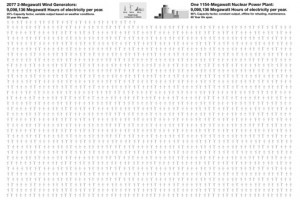Replacing nuclear with wind power: Could it be done?
Many people would like it to be theoretically possible to replace nuclear power with wind power, since the wind is a free resource. The way that I would like to approach the topic is to not discuss the source of power, but to discuss this question from the perspective of "intermittency." Stating the question another way: Can an intermittent source replace a baseload power source for producing electricity? This question has nothing to do with how the electricity is generated, but everything to do with when the electricity is generated.
The production of electricity involves understanding concepts such as capacity, capacity factor, and generation. These three concepts are often misunderstood and misused when comparing the generation of intermittent electricity with baseload generated electricity. It is sometimes useful to use a familiar analogy when explaining complicated topics. I will, therefore, use the automobile for this analogy, since many of us own a car and everyone is familiar with them.
Capacity
Here is the analogy: Suppose there is a car on the market that is very environmentally friendly. Its mileage is phenomenal! I call it a "super-green" car.
This super-green car has the same horsepower as a conventional car. It will handle steep hills as well as a conventional car. It has the same 0 to 60 mph performance. The only difference is that when you try to start it in the morning, it will only start 25 percent of the time, and you can never predict on which day it will start. It runs, randomly, 25 percent of the time.
Would you replace your conventional car with a super-green car to get you to work every day? To keep the analogy simple, let us assume that if the car starts on a particular day, it will also take you home at the end of the workday. If it doesn't start on a particular day, however, it won't start that day no matter how often you turn the starter key.
To most people, the answer is obvious. Most of us would not hold on to a job very long if we randomly showed up at work only 25 percent of the time. So the answer is no, the super-green car cannot replace the conventional car. Horsepower is the equivalent of capacity in this analogy. An intermittent electrical power source with a capacity (or power capability when it is working) to generate 1000MW cannot replace a conventional power plant with a capacity of 1000MW. Even though the capacities are the same, the power plants are not equivalent. Yet capacity comparisons are made all the time, as if this somehow makes the power plants equivalent. They are not equivalent.
Capacity factor
Others would say that since the capacity factor is 25 percent (the car works 25 percent of the time), you would just need four cars to reliably get you to work every day. This is also not true, however. There is a chance that none of the cars will work on a particular day. As a matter of fact, this probability can be computed, if the probability of each car not working is independent of the other cars not working. It is 0.75 x 0.75 x 0.75 x 0.75 or (0.75)^4, which is equal to 32 percent. So if you owned four super-green cars, the probability of none of them working on a particular day is 32 percent. So, with four super-green cars, you get to work 68 percent of the time, which is better than 25 percent of the time, but it is still a long way from 100 percent of the time.

Another problem with using capacity factor as an equalizing parameter is that there are times when more than one car will start. The extra cars, however, are of no value to you as far as getting to work is concerned. The extra working cars do not average out with the demand to get to work on time each day. They are working at the wrong time.
Note that in the case of a wind farm, the probability of each turbine not working is not independent. If the wind doesn't blow in a particular area, it will affect all wind turbines. The probabilities are not randomly independent. Therefore, wind farms must be in separate weather patterns, in order to significantly reduce the unavailable time.
Generation
A better equalizing parameter is generation. When the super-green car works, it generates highly economical miles. That parameter has its problems as well, however. The generation of economical miles can be increased simply by taking the long route to work. Those extra economical miles are of no value as far as getting to work is concerned. In the same way, generated electricity has no value unless there is a demand for it at the time that it is generated. This is because electricity has zero shelf-life. It must be consumed when it is generated.
So, when generation cost comparisons are made between intermittent and baseload power sources, this presumes that the resulting electricity value is the same. This is actually not the case, because electricity generated when the demand for it is not certain does not have the same value as electricity that is generated when there is demand for it.
There is no perfect equalization parameter when making comparisons between intermittent and baseload generated electricity. Capacity is by far the worst, next comes capacity factor, and the best is generation, but it is not perfect.
Conclusion
So, the conclusion is that intermittently generated electricity cannot replace baseload generation. Just like there is a chance that none of the super-green cars are working on a particular day, there is also a chance that no electricity is generated by an intermittent source. Hence, all the conventional power sources are still needed.
Intermittent power sources can be of value, however, because they do save fuel in conventional power plants. But the economics are usually not very good at today's fuel prices. In the car analogy, I compute that my 20-mile round-trip commute to work would save me about two gallons of gas a month if the super-green car gets double the mileage of my conventional car. At $4 per gallon, that is $8 per month saving. It is obvious that, from an economic point of view, this saving is nowhere near the hundreds of dollars required per month to own an extra car. Similarly, I wrote an article explaining that wind farms cannot be justified on an economic basis, except in Hawaii, where expensive oil is used to generate electricity.
But perhaps using intermittent power plants can be justified environmentally. Perhaps not burning fossil fuels is worth the environmental benefit of not releasing as much greenhouse gases. Also, the fossil resource can be saved for other uses such as plastics. That argument breaks down, however, when the baseload generator is nuclear. Nuclear power does not generate greenhouse gases during operation. Saving the uranium for other uses is not applicable, because uranium has no other commercial uses. What exactly would we be saving it for?
So, to answer the general question, can wind power replace nuclear? The answer is clearly no. No technology is perfect, and there is always some impact in everything we do. Nuclear has the capability to meet the electrical needs for humanity for a millennia. That is a very compelling reason to use it, versus using a technology that only works intermittently and requires keeping all the conventional generators that we already have.
_____________________________
 Ulrich Decher holds a PhD in nuclear engineering. He is a member of the ANS Public Information Committee and a contributor to the ANS Nuclear Cafe.
Ulrich Decher holds a PhD in nuclear engineering. He is a member of the ANS Public Information Committee and a contributor to the ANS Nuclear Cafe.








